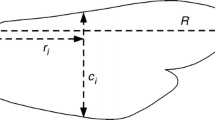Summary
Evolutionary stable dispersal and wing muscle histolysis strategies are studied in the waterstriderGerris thoracicus. These strategies relate to spreading reproductive risk. Overwintering individuals have the choice of dispersing to either a brackish sea bay or a rock pool habitat. The former is reproductively more favorable than the latter during warm dry years and less favorable during cool wet years. After spring migration, individuals may histolyse their flight muscles and lay all their eggs in one pool or they may retain their flight ability and lay fewer eggs in total but spread them in several pools. We use a simple two-habitat model to examine the question of habitat dispersal. Our results indicate that, although the value of the evolutionary stable dispersal depends on the degree of variability in the environment and on the probability of local extinctions in either habitat, the population always disperses to both habitats as a consequence of density dependent growth. We use a more detailed multiple-rockpool habitat model to examine the question of wing muscle histolysis as a response to density dependence. Our results indicate that a wing muscle histolysis response to population density is an evolutionarily stable strategy when compared with the two alternatives of females always histolysing or never histolysing their flight muscles. The application of evolutionarily stable theory to stochastic problems presents a number of difficulties. We discuss these difficulties in the context of computing evolutionarily stable strategies for the problems at hand.
Similar content being viewed by others
References
den Boer, P. J. (1968) Spreading the risk and stabilizing of animal numbers.Acta Biotheor. 18, 165–94.
Brown, J. S. and Vincent, T. L. (1987) Coevolution as an evolutionary game.Evolution 41, 66–79.
Cohen, D. (1967) Optimization of seasonal migratory behavior.Amer. Natur. 101, 5–17.
Ellner, S. (1984) Asymptotic behavior of some stochastic difference equation population models.J. Math. Biol. 19, 169–200.
Ellner, S. (1985a) ESS germination rates in randomly varying environments. I. Logistic-type models.Theor. Pop. Biol. 28, 50–79.
Ellner, S. (1985b) ESS germination rates in randomly varying environments. II. Reciprocal yield-law models.Theor. Pop. Biol. 28, 80–116.
Getz, W. M. and Kaitala, V. (1989) Ecogenetic models, competition, and heteropathy.Theor. Pop. Biol. 36, 34–58.
Hastings, A. (1983) Can spatial variation alone lead to selection for dispersal.Theor. Pop. Biol. 24, 244–51.
Kaitala, A. (1987) Dynamic life-history strategy of the waterstriderGerris thoracicus as an adaptation to food and habitat variation.Oikos 48, 125–31.
Kaitala, A. (1988) Wing muscle dimorphism: two reproductive pathways of the waterstriderGerris thoracicus in relation to habitat instability.Oikos 53, 222–8.
Kaitala, A. (1989) Reproductive behaviour of long-winged waterstriders (Heteroptera, Gerridea) in relation to food and habitat variation. Ph.D. dissertation, Laser-paino, Helsinki, May 1989.
Levin, S. A., Cohen, D. and Hastings, A. (1984) Dispersal strategies in patchy environments.Theor. Pop. Biol. 26, 165–91.
May, R. M. and Oster, G. (1976) Bifurcation and dynamic complexity in simple ecological models.Amer Natur. 110, 573–90.
Maynard Smith, J. (1976) Evolution and the theory of games.Amer. Sci. 64, 41–5.
Root, R. B. and Kareiva, P. (1984) The search for resources by cabbage butterflies (Pieris rapae): ecological consequences and adaptive significance of markovian movements in a patchy environment.Ecology 65, 147–65.
Root, R. B. and Kareiva, P. (1986) Is risk-spreading so unrealistic?Oikos 47, 114–16
Salemaa, M. (1984) Life history strategy of the waterstriderGerris thoracicus in the Finnish archipelago, M.Sc. thesis, Dept. of Zoology, Univ. of Helsinki. (In Finnish.)
Seger, J. and Brockmann, H. J. (1987) What is bet-hedging? InOxford Surveys of Evolutionary Biology (P. H. Harvey and L. Patridge, eds) vol. 4. pp. 182–211.
Stearns, S. C. (1976) Life history tactics: a review of the ideas.Quart. Rev. Biol. 51, 3–47.
Strathmann, R. (1974) The spread of sibling larvae of sedentary marine invertebrates.Amer. Natur. 108, 29–44.
Vepsäläinen, K. (1973) The distribution and habitats ofGerris Fabr. species (Heteroptera, Gerriadea) in Finland.Ann. Zool. Fennici 10, 419–44.
Vepsäläinen, K. (1978) Wing dimorphism and diapause inGerris: determination and adaptive significance. InEvolution of Insect Migration and Diapause (H. Dingle, ed.) pp. 218–53.
Vepsäläinen, K. and Patama, T. (1983) Allocation of reproductive energy in relation to the pattern of environment in fiveGerris species. InDiapause and Life Cycle Strategies in Insects. (V. K. Brown, and I. Hodek, eds) pp. 189–207. Junk, London.
Vepsäläinen, K., Kaitala, A. and Kaitala, V. (1985) Reproductive tactics of the waterstriderGerris thoracicus in unpredictable environments: a simulation study.Oikos 45, 266–72.
Author information
Authors and Affiliations
Rights and permissions
About this article
Cite this article
Kaitala, V., Kaitala, A. & Getz, W.M. Evolutionarily stable dispersal of a waterstrider in a temporally and spatially heterogeneous environment. Evol Ecol 3, 283–298 (1989). https://doi.org/10.1007/BF02285260
Issue Date:
DOI: https://doi.org/10.1007/BF02285260




